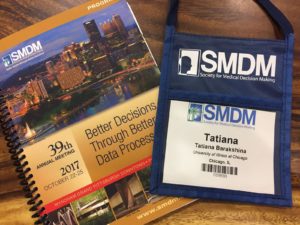Society of Medical Decision-Making Conference – Greetings from Pittsburgh, PA!
 As an academic and a corporate marketing researcher, I attend close to ten professional conferences a year. Today, I want to reflect on why the Society of Medical Decision Making 39th Annual Conference stands out from the rest of the events I’ve attended this year and what makes it special and unique. A distinguishing feature of the SMDM meeting is the absence of profession boundaries. The conference is attended by a diverse group of healthcare professionals, driven by the common goal of improving quality of medical decisions. Attendees come from three main areas and blend together seamlessly. From academic researchers (health policy, public health, health services, biostatistics, medical psychology university departments), to medical practitioners (GPs, surgeons, radiologists), and policy makers (FDA, CDC) – each of these distinct groups is well represented and complement each others’ experience, knowledge and expertise.
As an academic and a corporate marketing researcher, I attend close to ten professional conferences a year. Today, I want to reflect on why the Society of Medical Decision Making 39th Annual Conference stands out from the rest of the events I’ve attended this year and what makes it special and unique. A distinguishing feature of the SMDM meeting is the absence of profession boundaries. The conference is attended by a diverse group of healthcare professionals, driven by the common goal of improving quality of medical decisions. Attendees come from three main areas and blend together seamlessly. From academic researchers (health policy, public health, health services, biostatistics, medical psychology university departments), to medical practitioners (GPs, surgeons, radiologists), and policy makers (FDA, CDC) – each of these distinct groups is well represented and complement each others’ experience, knowledge and expertise.
Let’s briefly review several SMDM talks I found particularly revealing, inspiring, and practically useful.
The opening message was delivered by the 21st U.S. Secretary of the Department of Health and Human Services, Kathleen Sebelius. She distilled the two key areas in public health – digital data access and disease prevention – which she views as a top priority for policy makers. She spoke about the current difficult times of the U.S. healthcare industry’s transition to personalized, digital medicine. While electronic health records (EHRs) have been widely implemented by now in a majority of American hospitals, the functionality is far from perfect, which causes process inefficiencies and frustration. But there is now way back. Digitalized data, immediate online access to patient records and test results is the way of the future. One initiative that illustrates new capabilities, or the EHR era, is a concept similar to online research panels. Essentially, Secretary Sibelius talked about a big patient panel, which can be used for clinical trials. A pool of patients across different demographics and diseases, potentially interested to participate in clinical trials, would help to recruit for clinical trials easier, faster and cheaper. This work is already underway.
In the late morning session, Joanna Hart, MD, presented a project looking at physician competency in the use of choice architecture. This presentation was widely discussed and received a lot of attention from the audience. Dr. Hart and her collaborators developed an experiment, where physicians were asked to assess potential biases in alternative ways choice architecture is presented to patients. The work tested physicians’ awareness of choice architecture principles and revealed that physicians don’t often recognize anchoring bias and multiple alternative biases when presenting options to patients. After researchers further debriefed the physicians in a semi-structured depth interviews, they were open to learn and improve on better recognizing these biases.
The third session, which I personally found very useful, was run by a panel of U.S. Food and Drug Administration (FDA) experts, describing the current process of incorporating patient-reported measures on FDA’s regulatory decision making. Representatives from each of the regulated areas — Drugs, Biologics, and Devices (all under the umbrella of the Office of Medical Products and Tobacco) — talked about the role of patient-sourced information in reviewing and approving drugs and medical devices for public use. Among the measures discussed:
- PRO (patient-reported outcomes), which includes pain intensity, seizure episodes, quality of life
- PPI (patient preference information), typically elicited through surveys and discrete choice models
- Patient community input (conversations with patient activist groups to better understand factors impacting burden of disease and burden of treatment)
From this session, it was evident that the FDA considers patient-reported information to be important scientific evidence that has a direct impact on medical product evaluation.
The conference ran for 3 days this week, with a lot of talks for me to attend and reflect upon. The next SMDM North American meeting is in Montreal, Canada. Hope to see you there in October of 2018!
Best,
Tatiana
#SMDM17

Sorry, the comment form is closed at this time.